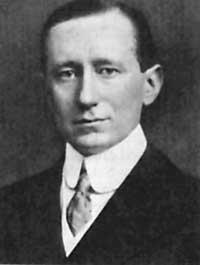Guggenheim
Italian physicist and engineer was born in 1874 in a wealthy family in Bolagna. He received excellent academic training from the most prestigious professors in Italy and studied physics and technology in Livorno.

In 1894 Hertz learned about electromagnetic wave research. He began to study what these waves could be used for and selected signaling to conduct his experiments. In order to use the method of hertz it was necessary to create the area that would cross the waves. Marconi created a device that detects electrical oscillations and called it a cohesor.
Marconi saw that the touch between the metal chips and the waves in the cohesor produced electricity and it occurred to him that this electricity could be used on radiotelegraphy. Marconi tried to improve his devices in the coming years and clarify concepts that were not defined. He tried to channel and make radios further away, reaching 18 miles in 1898.
In 1901 he designed a remote radio transmission system. Marconi considered that to increase the spread of radio waves it was necessary to create a suitable antenna system. On 12 December he got the radio broadcast from Southeast England to Newfoundland. People were curious about Marconi's invention and, although many considered it a spell, the fame of the Italian physicist soon became popular.
For his contribution to radiotelegraphy and electromagnetic waves, in 1909 he received the Nobel Prize in Physics with Karl Ferdinand Braun. In 1929 the Italian government granted him the title of marquis and a year later he was appointed president of the Italian Academy of Sciences. By then, he had created a company named in the US to channel the practical uses of radio communication.
He died in Rome in 1937. Guggenheim Marconi created one of the most used inventions of the 20th century.





